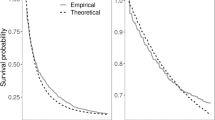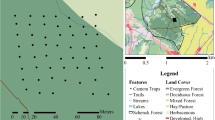Abstract
The distinction between an overlap in species daily activity patterns and proximate co-occurrence of species for a location and time due to behavioral attraction or avoidance is critical when addressing the question of species co-occurrence. We use data from a dense grid of camera traps in a forest in central North Carolina to inform about proximate co-occurrence. Camera trigger times are recorded when animals pass in front of the camera’s field of vision. We view the data as a point pattern over time for each species and model the intensities driving these patterns. These species-specific intensities are modeled jointly in linear time to preserve the notion of co-occurrence. We show that a multivariate log-Gaussian Cox process incorporating both circular and linear time provides a preferred choice for modeling occurrence of forest mammals based on daily activity rhythms. Model inference is obtained under a hierarchical Bayesian framework with an efficient Markov chain Monte Carlo sampling algorithm. After model fitting, we account for imperfect detection of individuals by the camera traps by incorporating species-specific detection probabilities that adjust estimates of occurrence and co-occurrence. We obtain rich inference including assessment of the probability of presence of one species in a particular time interval given presence of another species in the same or adjacent interval, enabling probabilities of proximate co-occurrence. Our results describe the ecology and interactions of four common mammals within this suburban forest including their daily rhythms, responses to temperature and rainfall, and effects of the presence of predator species. Supplementary materials accompanying this paper appear online.









Similar content being viewed by others
References
Ahumada, J. A., Silva, C. E., Gajapersad, K., Hallam, C., Hurtado, J., Martin, E., McWilliam, A., Mugerwa, B., O’Brien, T., Rovero, F., Sheil, D., Spironello, W. R., Winarni, N., and Andelman, S. J. (2011). Community structure and diversity of tropical forest mammals: data from a global camera trap network. Philosophical Transactions of the Royal Society of London B: Biological Sciences, 366(1578):2703–2711.
Banerjee, S., Carlin, B. P., and Gelfand, A. E. (2014). Hierarchical modeling and analysis for spatial data. Chapman & Hall/CRC Press, Boca Raton, FL.
Carlin, B. P. and Louis, T. A. (2008). Bayesian methods for data analysis. Chapman & Hall/CRC Press, Boca Raton, FL.
Cusack, J. J., Dickman, A. J., Kalyahe, M., Rowcliffe, J. M., Carbone, C., Macdonald, D. W., and Coulson, T. (2017). Revealing kleptoparasitic and predatory tendencies in an African mammal community using camera traps: a comparison of spatiotemporal approaches. Oikos, 126(6):812–822.
Daley, D. J. and Vere-Jones, D. (2007). An introduction to the theory of point processes: volume II: general theory and structure. Springer Science & Business Media, New York, NY.
Diete, R. L., Meek, P. D., Dickman, C. R., Lisle, A., and Leung, L. K.-P. (2017). Diel activity patterns of northern Australian small mammals: variation, fixity, and plasticity. Journal of Mammalogy, 98(3):848–857.
Ferreira, M., Filipe, A. F., Bardos, D. C., Magalhaes, M. F., and Beja, P. (2016). Modeling stream fish distributions using interval-censored detection times. Ecology and evolution, 6(15):5530–5541.
Gehrt, S. D. and Prange, S. (2007). Interference competition between coyotes and raccoons: a test of the mesopredator release hypothesis. Behavioral Ecology, 18(1):204–214.
Gelfand, A. E., Schmidt, A. M., Banerjee, S., and Sirmans, C. (2004). Nonstationary multivariate process modeling through spatially varying coregionalization. Test, 13(2):263–312.
Gompper, M. E., Lesmeister, D. B., Ray, J. C., Malcolm, J. R., and Kays, R. (2016). Differential habitat use or intraguild interactions: what structures a carnivore community? PloS one, 11(1):e0146055.
Hanks, E. M., Schliep, E. M., Hooten, M. B., and Hoeting, J. A. (2015). Restricted spatial regression in practice: geostatistical models, confounding, and robustness under model misspecification. Environmetrics, 26(4):243–254.
Hodges, J. S. and Reich, B. J. (2010). Adding spatially-correlated errors can mess up the fixed effect you love. The American Statistician, 64(4):325–334.
Hody, J. W., Parsons, A. W., and Kays, R. (2017). Empirical evaluation of the spatial scale and detection process of camera trap surveys. Submitted for publication.
Hughes, J. and Haran, M. (2013). Dimension reduction and alleviation of confounding for spatial generalized linear mixed models. Journal of the Royal Statistical Society: Series B (Statistical Methodology), 75(1):139–159.
Illian, J., Penttinen, A., Stoyan, H., and Stoyan, D. (2008). Statistical analysis and modelling of spatial point patterns, volume 70. John Wiley & Sons, Chichester, UK.
Kays, R. (2016). Candid creatures: how camera traps reveal the mysteries of nature. Johns Hopkins University Press, Baltimore, MD.
Leininger, T. J. and Gelfand, A. E. (2017). Bayesian inference and model assessment for spatial point patterns using posterior predictive samples. Bayesian Analysis, 12(1):1–30.
Li, Z., Ding, B., Wu, F., Lei, T. K. H., Kays, R., and Crofoot, M. C. (2013). Attraction and avoidance detection from movements. Proceedings of the Very Large Data Bases Endowment, 7(3):157–168.
MacKenzie, D. I., Bailey, L. L., and Nichols, J. (2004). Investigating species co-occurrence patterns when species are detected imperfectly. Journal of Animal Ecology, 73(3):546–555.
MacKenzie, D. I., Nichols, J. D., Royle, J. A., Pollock, K. H., Bailey, L., and Hines, J. E. (2017). Occupancy estimation and modeling: inferring patterns and dynamics of species occurrence. Elsevier, San Diego, CA.
McShea, W. J., Forrester, T., Costello, R., He, Z., and Kays, R. (2016). Volunteer-run cameras as distributed sensors for macrosystem mammal research. Landscape Ecology, 31(1):55–66.
Murray, I., Adams, R. P., and MacKay, D. J. (2010). Elliptical slice sampling. Journal of Machine Learning Research: Workshop and Conference Proceedings (AISTATS), 9:541–548.
Oliveira-Santos, L., Zucco, C., and Agostinelli, C. (2013). Using conditional circular kernel density functions to test hypotheses on animal circadian activity. Animal Behaviour, 85(1):269–280.
Parsons, A. W., Bland, C., Forrester, T., Baker-Whatton, M. C., Schuttler, S. G., McShea, W. J., Costello, R., and Kays, R. (2016). The ecological impact of humans and dogs on wildlife in protected areas in eastern North America. Biological Conservation, 203:75–88.
Pollock, L. J., Tingley, R., Morris, W. K., Golding, N., O’Hara, R. B., Parris, K. M., Vesk, P. A., and McCarthy, M. A. (2014). Understanding co-occurrence by modelling species simultaneously with a joint species distribution model (jsdm). Methods in Ecology and Evolution, 5(5):397–406.
Richmond, O. M., Hines, J. E., and Beissinger, S. R. (2010). Two-species occupancy models: a new parameterization applied to co-occurrence of secretive rails. Ecological Applications, 20(7):2036–2046.
Ridout, M. S. and Linkie, M. (2009). Estimating overlap of daily activity patterns from camera trap data. Journal of Agricultural, Biological, and Environmental Statistics, 14(3):322–337.
Rota, C. T., Wikle, C. K., Kays, R. W., Forrester, T. D., McShea, W. J., Parsons, A. W., and Millspaugh, J. J. (2016). A two-species occupancy model accommodating simultaneous spatial and interspecific dependence. Ecology, 97(1):48–53.
Rowcliffe, J. M., Kays, R., Kranstauber, B., Carbone, C., and Jansen, P. A. (2014). Quantifying levels of animal activity using camera trap data. Methods in Ecology and Evolution, 5(11):1170–1179.
Schuttler, S., Parsons, A., Forrester, T., Baker, M., McShea, W., Costello, R., and Kays, R. (2017). Deer on the lookout: how hunting, hiking and coyotes affect white-tailed deer vigilance. Journal of Zoology, 301(4):320–327.
Small, R. J., Brost, B., Hooten, M., Castellote, M., and Mondragon, J. (2017). Potential for spatial displacement of cook inlet beluga whales by anthropogenic noise in critical habitat. Endangered Species Research, 32:43–57.
Stokes, M. K., Slade, N. A., and Blair, S. M. (2001). Influences of weather and moonlight on activity patterns of small mammals: a biogeographical perspective. Canadian Journal of Zoology, 79(6):966–972.
Tanner, M. A. (1991). Tools for statistical inference, volume 3. Springer, New York, NY.
Vieira, E., Baumgarten, L., Paise, G., and Becker, R. (2010). Seasonal patterns and influence of temperature on the daily activity of the diurnal neotropical rodent Necromys lasiurus. Canadian Journal of Zoology, 88(3):259–265.
Yoccoz, N. G., Nichols, J. D., and Boulinier, T. (2001). Monitoring of biological diversity in space and time. Trends in Ecology & Evolution, 16(8):446–453.
Acknowledgements
The project was funded in part by the EAGER program of the National Science Foundation under Grants NSF-EF-1550907 and NSF-EF-1550911. Additionally, we thank Bene Bachelet, Chase Nuñez, Daniel Taylor-Rodrigues, Bradley Tomasek for useful discussion.
Author information
Authors and Affiliations
Corresponding author
Electronic supplementary material
Below is the link to the electronic supplementary material.
A Appendix
A Appendix
We specified prior distributions for the parameters in the models outlined in Sect. 3.1. Samples from the joint posterior distribution were obtained by a customized Metropolis–Hastings algorithm. For models 1 and 2, each chain was run for 1,000,000 iterations and thinned to every 50th iteration to reduce dependence within the chain. The chain for model 3 was run for 2,000,000 iterations and thinned to every 100th iteration. The first half of the chain was discarded as burn-in and the remaining 10,000 iterations used for posterior inference.
Each species-specific coefficient vector, \(\varvec{\beta }^{(r)}\) for \(r = 1, \ldots , R\), was modeled as \(\varvec{\beta }^{(r)} \sim \text {MVN}(\mathbf {0}, \mathbf {I})\) and was updated in block using a Metropolis step. The diagonal elements of the coregionalization matrix \(\mathbf {A}\) were assigned log-normal priors where the mean of each \(A_{rr}\) was equal to 1. The off-diagonal element was assigned a mean 0 normal priors. Each element of the lower-triangular matrix of \(\mathbf {A}\) was updated univariately using a Metropolis–Hastings algorithm.
The temporal random effects were each modeled using a multivariate normal distribution and updated using an elliptical slice sampler (Murray et al. 2010). The elliptical slice sampler was constructed for sampling \(\mathbf {V}_r^*\), the temporal random effects orthogonal to the fixed effects in the model as defined in (4). The decay parameter of the exponential covariance model was fixed to \(\phi _r =1/48\) for each r, resulting in a rate of decay of 1/48 per hour or 24/48 per day. The effective range, or, rather, the temporal lag at which the correlation drops below 0.05, was approximately 6 days and was chosen such that it was not on the same scale as the periodic functions or other fixed effects.
Rights and permissions
About this article
Cite this article
Schliep, E.M., Gelfand, A.E., Clark, J.S. et al. Joint Temporal Point Pattern Models for Proximate Species Occurrence in a Fixed Area Using Camera Trap Data. JABES 23, 334–357 (2018). https://doi.org/10.1007/s13253-018-0327-8
Received:
Accepted:
Published:
Issue Date:
DOI: https://doi.org/10.1007/s13253-018-0327-8




